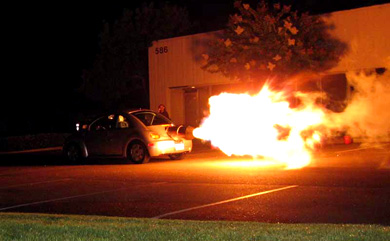Forget that sport pilot stuff. If I ever lose my medical, I’m building one of these:

Even Bubb Rubb wouldn’t be able to handle this thing. According to the builder:
This is a street-legal jet car. The car has two engines: the production gasoline engine in the front driving the front wheels and the jet engine in the back. The idea is that you drive around legally on the gasoline engine and when you want to have some fun, you spin up the jet and get on the burner (you can start the jet while driving along on the gasoline engine).

Apparently, the car is licensed here in California.
In California, new cars have bi-annual smog inspections so if you modify the engine, it is likely to fail the inspection and you won’t be able to drive it on the street. There are some exempt engine modifications (ex. after-cat mufflers – big deal) but none that will allow you to add 1350 hp to a new car.

Kerosene is stored in a custom 14 gallon, baffled, foam-filled kevlar fuel cell in the spare tire well. Two fuel exits in the back: a -12 on the left side and a -10 on the right. The -10 goes to a shutoff, then a Barry Grant pump (one of the few hot rod parts on the car), then up into the car where it sees a filter, a regulator, and an electrical shutoff valve before feeding the engine. The -12 goes into a shutoff, then a 1.5 hp, 11,000 rpm, 24V custom electric pump.  Pump is magnesium and can maintain 100 psi at 550 gph. From the pump it goes into the car to a filter, then a large regulator, and then to the afterburner solenoid and the big-fire solenoid (to left of pump and feeding bottom of tailpipe through orange covered hose). Fuel system was tested for flow capability.
 Â
Â
The engine is a General Electric Model T58-8F. This is a helicopter turboshaft engine that was converted to a jet by some internal modifications and a custom tailpipe. The engine spins up to 26,000 RPM (idle is 13,000 RPM), draws air at 11,000 CFM, and is rated at 1350 hp. It weighs only 300 lbs. It grows as it warms up so the engine mounts have to account for this. The mounts in the front are rubber and the back are sliding mounts on rubber. The structure holding the engine was designed using finite element analysis and is redundant. Strong, damage tolerant, and light. Second battery and fuse/relay panel on the right, halon fire system and 5 gallon dry sump tank on left. 24V starter motor is in the nose of the engine. 700 A of current goes into that motor for 20 seconds during start-up. Due to heat, must limit starts to three in one hour. Big screen is to avoid FOD (foreign object damage).

My favorite part? “The jet keeps sucking the rose out of the bud vase on the dash!”
A Quicktime video is available here.

LOL!
A little more advanced that strapping some JATO rockets to the top of you car I suppose.
The intake guard reminds me of seeing the F-18’s and F-14’s out on the flightline during exercises like CAX and WTI ( I was Marine avitation, worked on the AV8B), there was always the rumor that when they did high power turns you could get close to the high power screens, and the would suck you up on to them.
I never witnessed it personally but sounded crazy as hell if someone was really dumb enough to try it.
You couldn’t really play around like that on the Harrier. We had no screens to protect us from being sucked up during a high power run.
Situational awareness and ORM was our only defense…
It’s a nice experience to fit the jet engine into a publicly use car. However, it should be installed into a huge car instead of latest “ Foxy â€. I don’t know that how foxy is running on the road like jet in the sky.
HAHA! That is awesome! How fast does it go?
NOT yur average bbq!!!! aw sh8t im to good fo tis